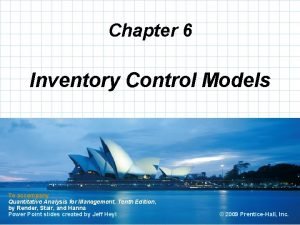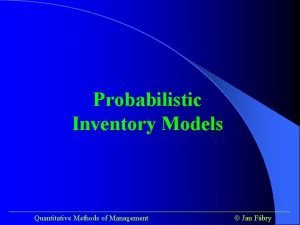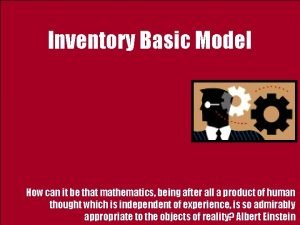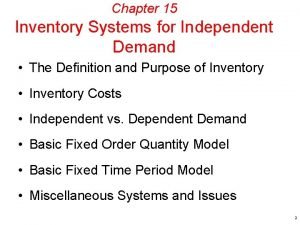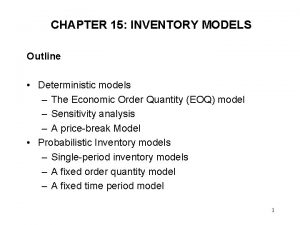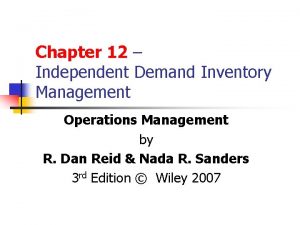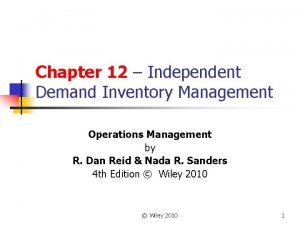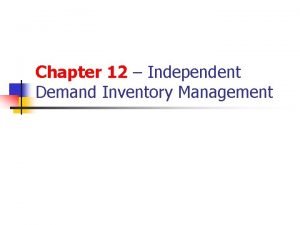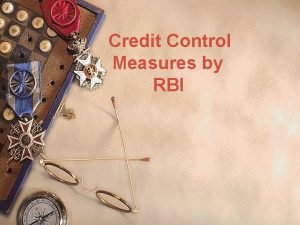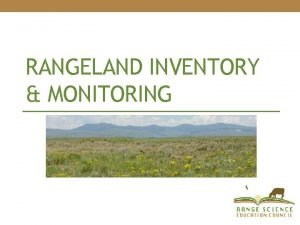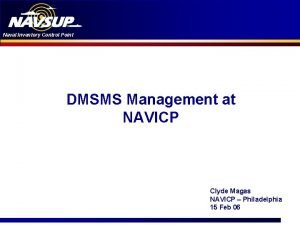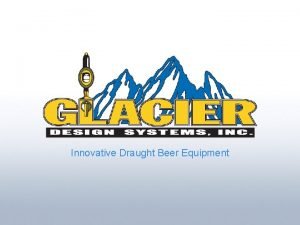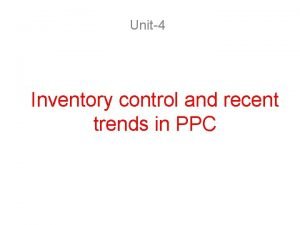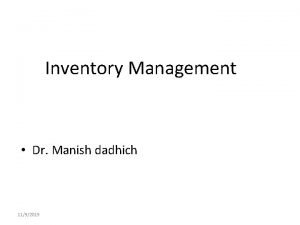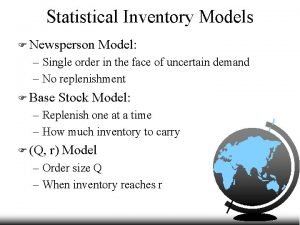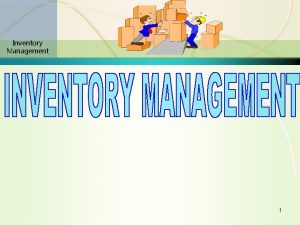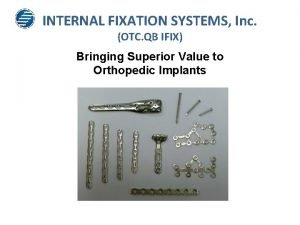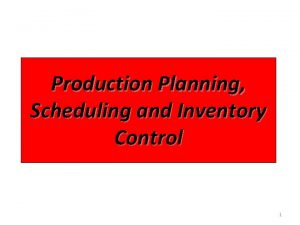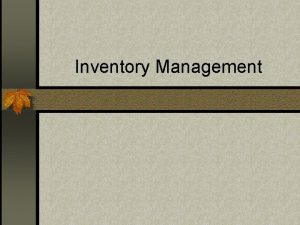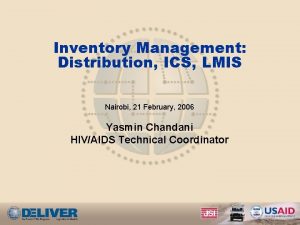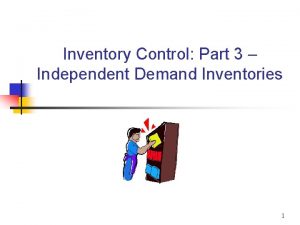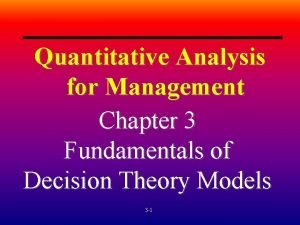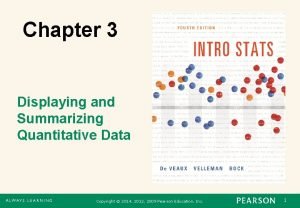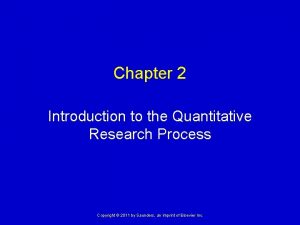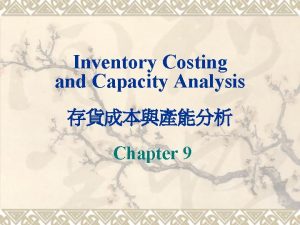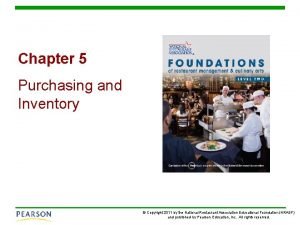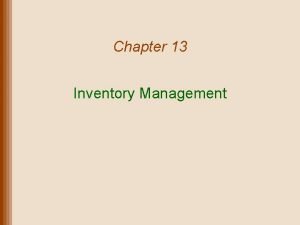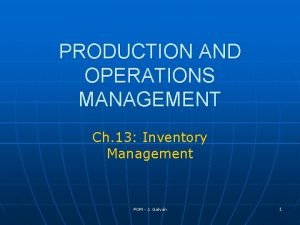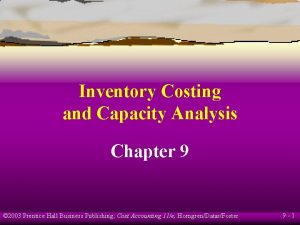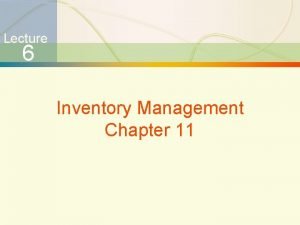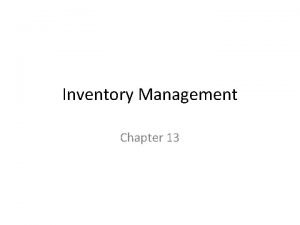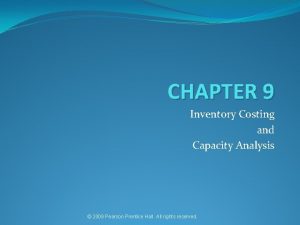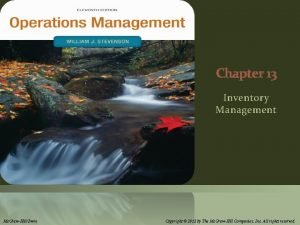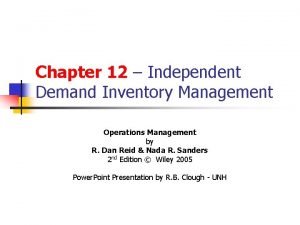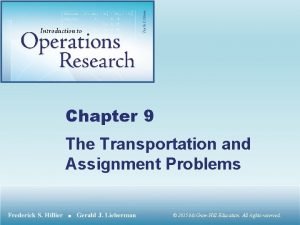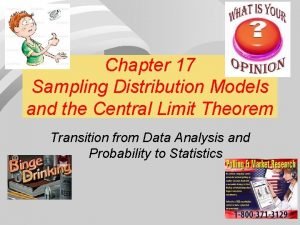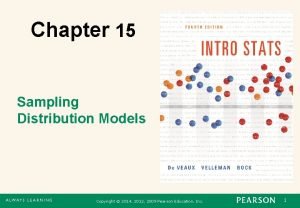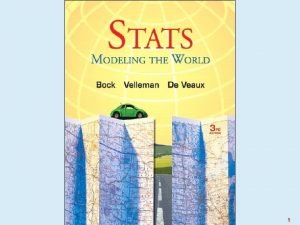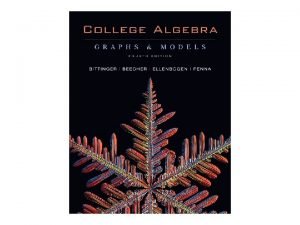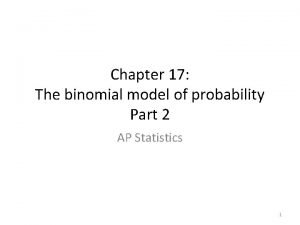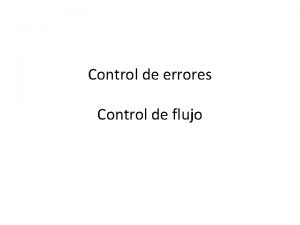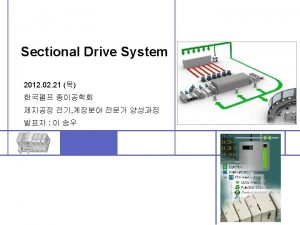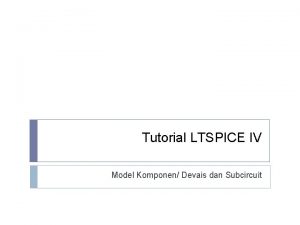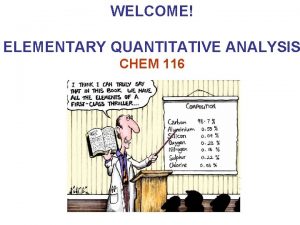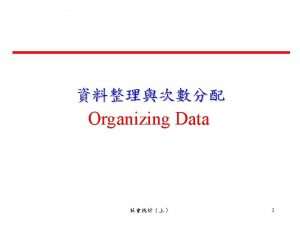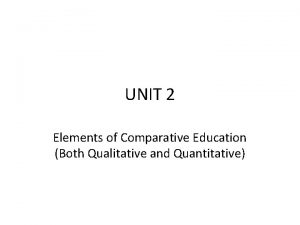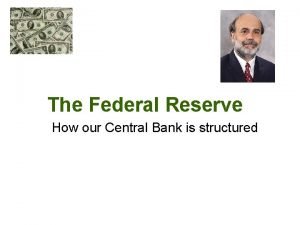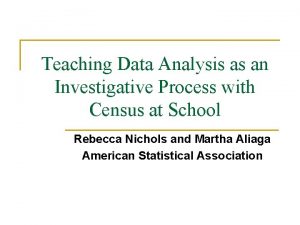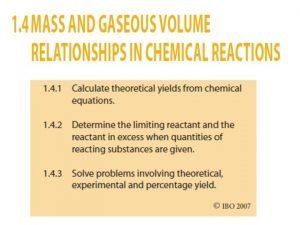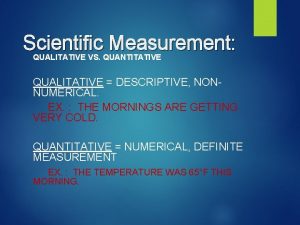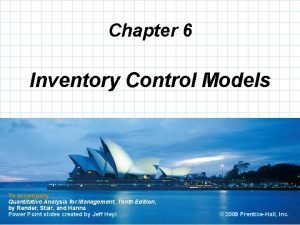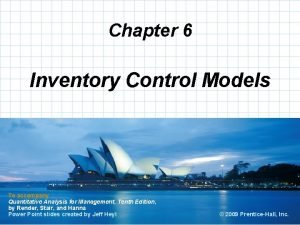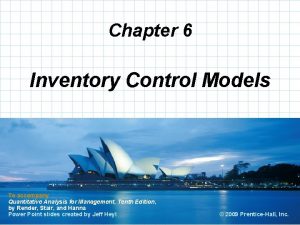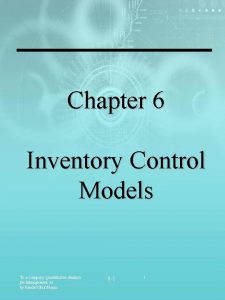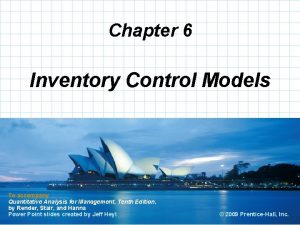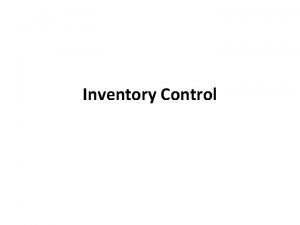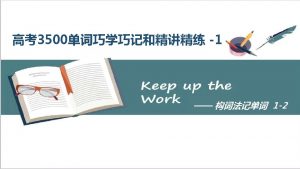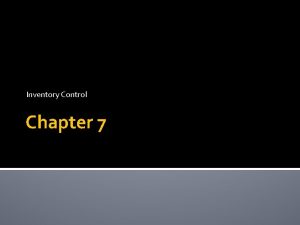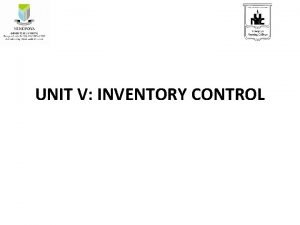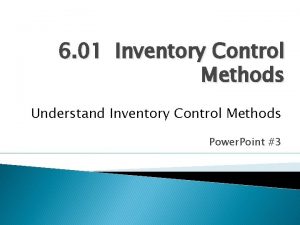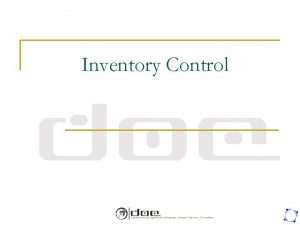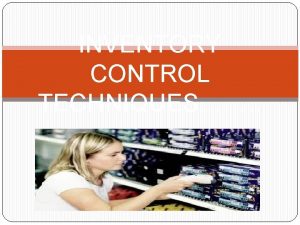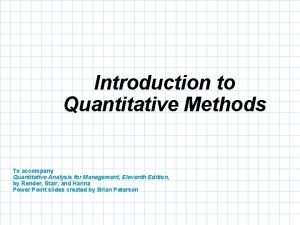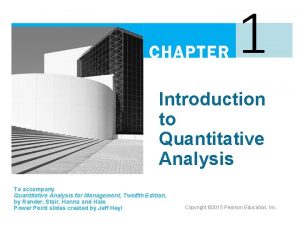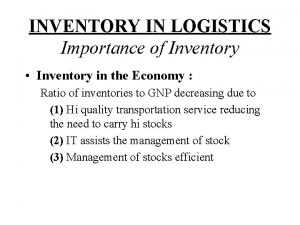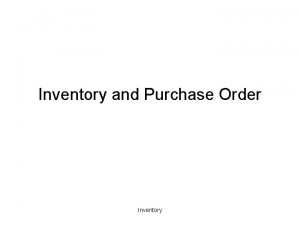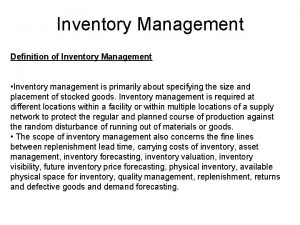Chapter 6 Inventory Control Models To accompany Quantitative















































































- Slides: 79

Chapter 6 Inventory Control Models To accompany Quantitative Analysis for Management, Tenth Edition, by Render, Stair, and Hanna Power Point slides created by Jeff Heyl © 2008 Prentice-Hall, Inc. © 2009 Prentice-Hall, Inc.

Introduction n Inventory is an expensive and important asset n n n to many companies Lower inventory levels can reduce costs Low inventory levels may result in stockouts and dissatisfied customers Most companies try to balance high and low inventory levels with cost minimization as a goal Inventory is any stored resource used to satisfy a current or future need Common examples are raw materials, work-in -process, and finished goods © 2009 Prentice-Hall, Inc. 6– 2

Introduction n Basic components of inventory planning n Planning what inventory is to be stocked and how it is to be acquired (purchased or manufactured) n This information is used in forecasting demand for the inventory and in controlling inventory levels n Feedback provides a means to revise the plan and forecast based on experiences and observations © 2009 Prentice-Hall, Inc. 6– 3

Introduction n Inventory may account for 50% of the total invested capital of an organization and 70% of the cost of goods sold © 2009 Prentice-Hall, Inc. 6– 4

Introduction n All organizations have some type of inventory control system n Inventory planning helps determine what goods and/or services need to be produced n Inventory planning helps determine whether the organization produces the goods or services or whether they are purchased from another organization n Inventory planning also involves demand forecasting © 2009 Prentice-Hall, Inc. 6– 5

The Inventory Process Suppliers Customers Inventory Storage Raw Materials Finished Goods Fabrication/ Work in Assembly Process Inventory Processing © 2009 Prentice-Hall, Inc. 6– 6

Introduction n Inventory planning and control Planning on What Inventory to Stock and How to Acquire It Forecasting Parts/Product Demand Controlling Inventory Levels Feedback Measurements to Revise Plans and Forecasts Figure 6. 1 © 2009 Prentice-Hall, Inc. 6– 7

Importance of Inventory Control n Five uses of inventory n The decoupling function n Storing resources n Irregular supply and demand n Quantity discounts n Avoiding stockouts and shortages n The decoupling function n Used as a buffer between stages in a manufacturing process n Reduces delays and improves efficiency © 2009 Prentice-Hall, Inc. 6– 8

Importance of Inventory Control n Storing resources n Seasonal products may be stored to satisfy off -season demand n Materials can be stored as raw materials, work -in-process, or finished goods n Labor can be stored as a component of partially completed subassemblies n Irregular supply and demand n Demand supply may not be constant over time n Inventory can be used to buffer the variability © 2009 Prentice-Hall, Inc. 6– 9

Importance of Inventory Control n Quantity discounts n Lower prices may be available for larger orders n Cost of item is reduced but storage and insurance costs increase, as well as the chances for more spoilage, damage and theft. n Investing in inventory reduces the available funds for other projects n Avoiding stockouts and shortages n Stockouts may result in lost sales n Dissatisfied customers may choose to buy from another supplier © 2009 Prentice-Hall, Inc. 6 – 10

Inventory Decisions n There are only two fundamental decisions in controlling inventory n How much to order n When to order n The major objective is to minimize total inventory costs n Common inventory costs are n Cost of the items (purchase or material cost) n Cost of ordering n Cost of carrying, or holding, inventory n Cost of stockouts © 2009 Prentice-Hall, Inc. 6 – 11

Inventory Cost Factors ORDERING COST FACTORS CARRYING COST FACTORS Developing and sending purchase orders Cost of capital Processing and inspecting incoming inventory Taxes Bill paying Insurance Inventory inquiries Spoilage Utilities, phone bills, and so on, for the purchasing department Theft Salaries and wages for the purchasing department employees Obsolescence Supplies such as forms and paper for the purchasing department Salaries and wages for warehouse employees Utilities and building costs for the warehouse Supplies such as forms and paper for the warehouse Table 6. 1 © 2009 Prentice-Hall, Inc. 6 – 12

Inventory Cost Factors n Ordering costs are generally independent of order quantity n Many involve personnel time n The amount of work is the same no matter the size of the order n Carrying costs generally varies with the amount of inventory, or the order size n The labor, space, and other costs increase as the order size increases n Of course, the actual cost of items purchased varies with the quantity purchased © 2009 Prentice-Hall, Inc. 6 – 13

Economic Order Quantity n The economic order quantity (EOQ) EOQ model is one of the oldest and most commonly known inventory control techniques n It dates from a 1915 publication by Ford W. Harris n It is still used by a large number of organizations today n It is easy to use but has a number of important assumptions © 2009 Prentice-Hall, Inc. 6 – 14

Economic Order Quantity n Assumptions 1. 2. 3. Demand is known and constant Lead time (the time between the placement and receipt of an order) is known and constant Receipt of inventory is instantaneous § 4. 5. 6. Inventory from an order arrives in one batch, at one point in time Purchase cost per unit is constant throughout the year; no quantity discounts The only variable costs are the placing an order, ordering cost, cost and holding or storing inventory over time, holding or carrying cost, cost and these are constant throughout the year Orders are placed so that stockouts or shortages are avoided completely © 2009 Prentice-Hall, Inc. 6 – 15

Inventory Usage Over Time § Inventory usage has a sawtooth shape § Inventory jumps from 0 to the maximum when the shipment arrives § Because demand is constant over time, inventory drops at a uniform rate over time Inventory Level Order Quantity = Q = Maximum Inventory Level Minimum Inventory 0 Figure 6. 2 Time © 2009 Prentice-Hall, Inc. 6 – 16

EOQ Inventory Costs n The objective is to minimize total costs n n n The relevant costs are the ordering and carrying/holding costs, all other costs are constant. Thus, by minimizing the sum of the ordering and carrying costs, we are also minimizing the total costs The annual ordering cost is the number of orders per year times the cost of placing each order As the inventory level changes daily, use the average inventory level to determine annual holding or carrying cost n n The annual carrying cost equals the average inventory times the inventory carrying cost per unit per year The maximum inventory is Q and the average inventory is Q/2. © 2009 Prentice-Hall, Inc. 6 – 17

Inventory Costs in the EOQ Situation n Objective is generally to minimize total cost n Relevant costs are ordering costs and carrying costs INVENTORY LEVEL DAY BEGINNING ENDING AVERAGE April 1 (order received) 10 8 9 April 2 8 6 7 April 3 6 4 5 April 4 4 2 3 April 5 2 0 1 Maximum level April 1 = 10 units Total of daily averages = 9 + 7 + 5 + 3 + 1 = 25 Number of days = 5 Average inventory level = 25/5 = 5 units Table 6. 2 © 2009 Prentice-Hall, Inc. 6 – 18

Inventory Costs in the EOQ Situation n Develop an expression for the ordering cost. n Develop and expression for the carrying cost. n Set the ordering cost equal to the carrying cost. n Solve this equation for the optimal order quantity, Q*. Q* © 2009 Prentice-Hall, Inc. 6 – 19

Inventory Costs in the EOQ Situation n Mathematical equations can be developed using Q EOQ D Co Ch = number of pieces to order = Q* = optimal number of pieces to order = annual demand in units for the inventory item = ordering cost of each order = holding or carrying cost per unit per year Annual ordering cost Number of Ordering orders placed cost per year order © 2009 Prentice-Hall, Inc. 6 – 20

Inventory Costs in the EOQ Situation n Mathematical equations can be developed using Q EOQ D Co Ch = number of pieces to order = Q* = optimal number of pieces to order = annual demand in units for the inventory item = ordering cost of each order = holding or carrying cost per unit per year Average Annual holding cost inventory Carrying cost per unit per year n Total Inventory Cost = © 2009 Prentice-Hall, Inc. 6 – 21

Inventory Costs in the EOQ Situation Optimal Order Quantity is when the Total Cost curve is at its lowest. This occurs when the Ordering Cost = Carrying Cost Curve of Total Cost of Carrying and Ordering Minimum Total Cost Carrying Cost Curve Ordering Cost Curve Figure 6. 3 Optimal Order Quantity © 2009 Prentice-Hall, Inc. 6 – 22

Finding the EOQ n When the EOQ assumptions are met, total cost is minimized when Annual ordering cost = Annual holding cost n Solving for Q © 2009 Prentice-Hall, Inc. 6 – 23

Economic Order Quantity (EOQ) Model n Summary of equations © 2009 Prentice-Hall, Inc. 6 – 24

Sumco Pump Company Example n Company sells pump housings to other companies n Would like to reduce inventory costs by finding optimal order quantity n Finding Total Annual Cost n Annual demand = 1, 000 units n Ordering cost = $10 per order n Average carrying cost per unit per year = $0. 50 © 2009 Prentice-Hall, Inc. 6 – 25

Sumco Pump Company Example © 2009 Prentice-Hall, Inc. 6 – 26

Sumco Pump Company Example Total annual cost = Order cost + Holding cost © 2009 Prentice-Hall, Inc. 6 – 27

Sumco Pump Company Example Program 6. 1 A © 2009 Prentice-Hall, Inc. 6 – 28

Sumco Pump Company Example Program 6. 1 B © 2009 Prentice-Hall, Inc. 6 – 29

Purchase Cost of Inventory Items n Total inventory cost can be written to include the cost of purchased items n Given the EOQ assumptions, the annual purchase cost is constant at D C no matter the order policy n C is the purchase cost per unit n D is the annual demand in units n It may be useful to know the average dollar level of inventory © 2009 Prentice-Hall, Inc. 6 – 30

Purchase Cost of Inventory Items n Inventory carrying cost is often expressed as an annual percentage of the unit cost or price of the inventory n This requires a new variable I Annual inventory holding charge as a percentage of unit price or cost n The cost of storing inventory for one year is then thus, © 2009 Prentice-Hall, Inc. 6 – 31

Sensitivity Analysis with the EOQ Model n The EOQ model assumes all values are know and fixed over time n Generally, however, the values are estimated or may change n Determining the effects of these changes is called sensitivity analysis n Because of the square root in the formula, changes in the inputs result in relatively small changes in the order quantity © 2009 Prentice-Hall, Inc. 6 – 32

Sensitivity Analysis with the EOQ Model n In the Sumco example n If the ordering cost were increased four times from $10 to $40, the order quantity would only double n In general, the EOQ changes by the square root of a change to any of the inputs © 2009 Prentice-Hall, Inc. 6 – 33

Reorder Point: Determining When To Order n Once the order quantity is determined, the next decision is when to order n The time between placing an order and its receipt is called the lead time (L) or delivery time n Inventory must be available during this period to met the demand n When to order is generally expressed as a reorder point (ROP) ROP – the inventory level at which an order should be placed ROP Demand per day Lead time for a new order in days d L © 2009 Prentice-Hall, Inc. 6 – 34

Determining the Reorder Point n The slope of the graph is the daily inventory usage n Expressed in units demanded per day, d n If an order is placed when the inventory level reaches the ROP, the new inventory arrives at the same instant the inventory is reaching 0 © 2009 Prentice-Hall, Inc. 6 – 35

Procomp’s Computer Chip Example n Demand for the computer chip is 8, 000 per year n Daily demand is 40 units n Delivery takes three working days ROP d L 40 units per day 3 days 120 units n An order is placed when the inventory reaches 120 units n The order arrives 3 days later just as the inventory is depleted © 2009 Prentice-Hall, Inc. 6 – 36

Inventory Level (Units) The Reorder Point (ROP) Curve Q* Slope = Units/Day = d ROP (Units) Lead Time (Days) L © 2009 Prentice-Hall, Inc. 6 – 37

EOQ Without The Instantaneous Receipt Assumption n When inventory accumulates over time, the instantaneous receipt assumption does not apply n Daily demand rate must be taken into account n The revised model is often called the production run model Inventory Level Part of Inventory Cycle During Which Production is Taking Place Maximum Inventory t There is No Production During This Part of the Inventory Cycle Time Figure 6. 5 © 2009 Prentice-Hall, Inc. 6 – 38

EOQ Without The Instantaneous Receipt Assumption n Instead of an ordering cost, there will be a setup cost – the cost of setting up the production facility to manufacture the desired product n Includes the salaries and wages of employees who are responsible for setting up the equipment, engineering and design costs of making the setup, paperwork, supplies, utilities, etc. n The optimal production quantity is derived by setting setup costs equal to holding or carrying costs and solving for the order quantity © 2009 Prentice-Hall, Inc. 6 – 39

Annual Carrying Cost for Production Run Model n In production runs, setup cost replaces ordering cost n The model uses the following variables Q number of pieces per order, or production run Cs setup cost Ch holding or carrying cost per unit per year p daily production rate d daily demand rate t length of production run in days © 2009 Prentice-Hall, Inc. 6 – 40

Annual Carrying Cost for Production Run Model Maximum inventory level (Total produced during the production run) – (Total used during the production run) (Daily production rate)(Number of days production) – (Daily demand)(Number of days production) (pt) – (dt) Total produced Q pt since we know Maximum inventory level © 2009 Prentice-Hall, Inc. 6 – 41

Annual Carrying Cost for Production Run Model n Since the average inventory is one-half the maximum and © 2009 Prentice-Hall, Inc. 6 – 42

Annual Setup Cost for Production Run Model n Setup cost replaces ordering cost when a product is produced over time (independent of the size of the order and the size of the production run) and © 2009 Prentice-Hall, Inc. 6 – 43

Determining the Optimal Production Quantity n By setting setup costs equal to holding costs, we can solve for the optimal order quantity Annual holding cost Annual setup cost n Solving for Q, we get © 2009 Prentice-Hall, Inc. 6 – 44

Production Run Model n Summary of equations If the situation does not involve production but receipt of inventory over a period of time, use the same model but replace Cs with Co © 2009 Prentice-Hall, Inc. 6 – 45

Brown Manufacturing Example n Brown Manufacturing produces commercial refrigeration units in batches Annual demand D 10, 000 units Setup cost Cs $100 Carrying cost Ch $0. 50 per unit per year Daily production rate p 80 units daily Daily demand rate d 60 units daily How many refrigeration units should Brown produce in each batch? How long should the production cycle last? © 2009 Prentice-Hall, Inc. 6 – 46

Brown Manufacturing Example 1. 2. © 2009 Prentice-Hall, Inc. 6 – 47

Brown Manufacturing Example Program 6. 2 A © 2009 Prentice-Hall, Inc. 6 – 48

Brown Manufacturing Example Program 6. 2 B © 2009 Prentice-Hall, Inc. 6 – 49

Quantity Discount Models n Quantity discounts are commonly available n The basic EOQ model is adjusted by adding in the purchase or materials cost Total cost Material cost + Ordering cost + Holding cost where D annual demand in units Cs ordering cost of each order C cost per unit Ch holding or carrying cost per unit per year © 2009 Prentice-Hall, Inc. 6 – 50

Quantity Discount Models Because unitare cost is now variable n Quantity discounts commonly available Holding Ch IC n The basic EOQ modelcost is adjusted by adding in the purchase materials cost I holdingorcost as a percentage of the unit cost (C) Total cost Material cost + Ordering cost + Holding cost where D annual demand in units Cs ordering cost of each order C cost per unit Ch holding or carrying cost per unit per year © 2009 Prentice-Hall, Inc. 6 – 51

Quantity Discount Models n A typical quantity discount schedule DISCOUNT NUMBER DISCOUNT QUANTITY DISCOUNT (%) DISCOUNT COST ($) 1 0 to 999 0 5. 00 2 1, 000 to 1, 999 4 4. 80 3 2, 000 and over 5 4. 75 Table 6. 3 n Buying at the lowest unit cost is not always the best choice © 2009 Prentice-Hall, Inc. 6 – 52

Quantity Discount Models n Total cost curve for the quantity discount model Total Cost $ TC Curve for Discount 3 TC Curve for Discount 1 TC Curve for Discount 2 EOQ for Discount 2 0 Figure 6. 6 1, 000 2, 000 Order Quantity © 2009 Prentice-Hall, Inc. 6 – 53

Brass Department Store Example n Brass Department Store stocks toy race cars n Their supplier has given them the quantity discount schedule shown in Table 6. 3 n Annual demand is 5, 000 cars, ordering cost is $49, and holding cost is 20% of the cost of the car n The first step is to compute EOQ values for each discount © 2009 Prentice-Hall, Inc. 6 – 54

Brass Department Store Example n The second step is adjust quantities below the allowable discount range n The EOQ for discount 1 is allowable n The EOQs for discounts 2 and 3 are outside the allowable range and have to be adjusted to the smallest quantity possible to purchase and receive the discount Q 1 700 Q 2 1, 000 Q 3 2, 000 © 2009 Prentice-Hall, Inc. 6 – 55

Brass Department Store Example n The third step is to compute the total cost for each quantity DISCOUNT NUMBER UNIT PRICE (C) ORDER QUANTITY (Q) ANNUAL MATERIAL COST ($) = DC ANNUAL ORDERING COST ($) = (D/Q)Co ANNUAL CARRYING COST ($) = (Q/2)Ch TOTAL ($) 1 $5. 00 700 25, 000 350. 00 25, 700. 00 2 4. 80 1, 000 245. 00 480. 00 24, 725. 00 3 4. 75 2, 000 23, 750 122. 50 950. 00 24, 822. 50 Table 6. 4 n The fourth step is to choose the alternative with the lowest total cost © 2009 Prentice-Hall, Inc. 6 – 56

Brass Department Store Example Program 6. 3 A © 2009 Prentice-Hall, Inc. 6 – 57

Brass Department Store Example Program 6. 3 B © 2009 Prentice-Hall, Inc. 6 – 58

Use of Safety Stock n If demand or the lead time are uncertain, the exact ROP will not be known with certainty n To prevent stockouts, stockouts it is necessary to carry extra inventory called safety stock n Safety stock can prevent stockouts when demand is unusually high n Safety stock can be implemented by adjusting the ROP © 2009 Prentice-Hall, Inc. 6 – 59

Use of Safety Stock n The basic ROP equation is ROP d L d daily demand (or average daily demand) L order lead time or the number of working days it takes to deliver an order (or average lead time) n A safety stock variable is added to the equation to accommodate uncertain demand during lead time ROP d L + SS where SS safety stock © 2009 Prentice-Hall, Inc. 6 – 60

Use of Safety Stock Inventory on Hand Time Figure 6. 7(a) Stockout © 2009 Prentice-Hall, Inc. 6 – 61

Use of Safety Stock Inventory on Hand Safety Stock, SS Stockout is Avoided Time Figure 6. 7(b) © 2009 Prentice-Hall, Inc. 6 – 62

Just-in-Time Inventory Control n To achieve greater efficiency in the production process, organizations have tried to have less in-process inventory on hand n This is known as JIT inventory n The inventory arrives just in time to be used during the manufacturing process n One technique of implementing JIT is a manual procedure called kanban © 2009 Prentice-Hall, Inc. 6 – 63

Just-in-Time Inventory Control n Kanban in Japanese means “card” n With a dual-card kanban system, there is a conveyance kanban, or C-kanban, and a production kanban, or P-kanban n Kanban systems are quite simple, but they require considerable discipline n Supplier or the warehouse delivers components to the production line only as and when they are needed n Production lines only produce/deliver desired components when they receive a card an empty container, indicating that more parts will be needed in production n As there is little inventory to cover variability, the schedule must be followed exactly © 2009 Prentice-Hall, Inc. 6 – 64

4 Steps of Kanban 1. 2. A user takes a container of parts or inventory along with its C-kanban to his or her work area When there are no more parts or the container is empty, the user returns the container along with the C-kanban to the producer area At the producer area, there is a full container of parts along with a P-kanban The user detaches the P-kanban from the full container and takes the container and the Ckanban back to his or her area for immediate use © 2009 Prentice-Hall, Inc. 6 – 65

4 Steps of Kanban 3. 4. The detached P-kanban goes back to the producer area along with the empty container The P-kanban is a signal that new parts are to be manufactured or that new parts are to be placed in the container and is attached to the container when it is filled This process repeats itself during the typical workday © 2009 Prentice-Hall, Inc. 6 – 66

The Kanban System P-kanban and Container C-kanban and Container 4 1 Producer Area Storage Area 3 User Area 2 Figure 6. 17 © 2009 Prentice-Hall, Inc. 6 – 67

Dependent Demand: The Case for Material Requirements Planning n All the inventory models discussed so far have assumed demand for one item is independent of the demand for any other item n However, in many situations items demand is dependent on demand for one or more other items n In these situations, MRP can be employed effectively n Material Requirements Planning (MRP) is an inventory model that can handle dependent demand n That means, the demand for inventory is not independent of the demand for another product © 2009 Prentice-Hall, Inc. 6 – 68

Dependent Demand: The Case for Material Requirements Planning n Some of the benefits of MRP are 1. Increased customer service levels 2. Reduced inventory costs 3. Better inventory planning and scheduling 4. Higher total sales 5. Faster response to market changes and shifts 6. Reduced inventory levels without reduced customer service n Most MRP systems are computerized, but the basic analysis is straightforward © 2009 Prentice-Hall, Inc. 6 – 69

Structure of the MRP System Data Files Output Reports BOM MRP by period report Master production schedule MRP by date report Lead times Planned order report (Item master file) Inventory data Purchasing data Material requirement planning programs (computer and software) Purchase advice Exception reports Order early or late or not needed Order quantity too small or too large © 2009 Prentice-Hall, Inc. 6 – 70

Enterprise Resource Planning n MRP has evolved to include not only the materials required in production, but also the labor hours, material cost, and other resources related to production n In this approach the term MRP II is often used and the word resource replaces the word requirements n As this concept evolved and sophisticated software was developed, these systems became known as enterprise resource planning (ERP) ERP systems © 2009 Prentice-Hall, Inc. 6 – 71

ERP Modules © 2009 Prentice-Hall, Inc. 6 – 72

ERP and MRP Customer Relationship Management Invoicing Sales Order (order entry, product configuration, sales management) Shipping Distributors, retailers, and end users © 2009 Prentice-Hall, Inc. 6 – 73

ERP and MRP Master Production Schedule Inventory Management Bills of Material MRP Work Orders Purchasing and Lead Times Table 13. 6 Routings and Lead Times © 2009 Prentice-Hall, Inc. 6 – 74

ERP and MRP Supply Chain Management Vendor Communication (schedules, EDI, advanced shipping notice, e-commerce, etc. ) Figure 14. 11 © 2009 Prentice-Hall, Inc. 6 – 75

Finance/ Accounting ERP and MRP Accounts Receivable General Ledger Accounts Payable Payroll Figure Table 14. 11 13. 6 © 2009 Prentice-Hall, Inc. 6 – 76

Enterprise Resource Planning n The objective of an ERP System is to reduce costs by integrating all of the operations of a firm n Starts with the supplier of materials needed and flows through the organization to include invoicing the customer of the final product n Data are entered only once into a database where it can be quickly and easily accessed by anyone in the organization n Benefits include n Reduced transaction costs n Increased speed and accuracy of information n Almost all areas of the firm benefit © 2009 Prentice-Hall, Inc. 6 – 77

Enterprise Resource Planning n There are drawbacks n The software is expensive to buy and costly to customize n Small systems can cost hundreds of thousands of dollars n Large systems can cost hundreds of millions n The implementation of an ERP system may require a company to change its normal operations n Employees are often resistant to change n Training employees on the use of the new software can be expensive © 2009 Prentice-Hall, Inc. 6 – 78

ERP Commercial Software n The most common ones are from the firms n SAP, n Oracle, n People Soft, n Baan, and n JD Edwards. n Even small systems can cost hundreds of thousands of dollars. n The larger systems can cost hundreds of millions of dollars. © 2009 Prentice-Hall, Inc. 6 – 79
 Accompany chapter 1
Accompany chapter 1 Inventory control model
Inventory control model Things that accompany salvation
Things that accompany salvation Median cubital vein
Median cubital vein Accompany
Accompany Probabilistic models and safety stock
Probabilistic models and safety stock 4500/800000
4500/800000 Dependent demand items
Dependent demand items Stochastic inventory model example
Stochastic inventory model example Independent demand inventory system
Independent demand inventory system Deterministic and probabilistic inventory models
Deterministic and probabilistic inventory models Inventory models for independent demand
Inventory models for independent demand Inventory models for independent demand
Inventory models for independent demand Deterministic and stochastic inventory models
Deterministic and stochastic inventory models Independent demand inventory
Independent demand inventory What is the difference between modals and semi modals?
What is the difference between modals and semi modals? Credit control tools
Credit control tools Smart goals examples for inventory control
Smart goals examples for inventory control Golf analysis in inventory management
Golf analysis in inventory management Inventory control definition
Inventory control definition Inventory control point
Inventory control point Freepour beverage management
Freepour beverage management Abc analysis in ppc
Abc analysis in ppc Fsn analysis example
Fsn analysis example Eyeball system inventory control
Eyeball system inventory control Statistical inventory control
Statistical inventory control Objectives of inventory control
Objectives of inventory control Synthes mini frag inventory control
Synthes mini frag inventory control Inventory management and production planning and scheduling
Inventory management and production planning and scheduling Introduction to inventory management
Introduction to inventory management Lmis kemsa
Lmis kemsa What are the 4 types of inventory?
What are the 4 types of inventory? Chapter 3 research respondents
Chapter 3 research respondents Quantitative analysis for management chapter 3 answers
Quantitative analysis for management chapter 3 answers Chapter 3 displaying and summarizing quantitative data
Chapter 3 displaying and summarizing quantitative data Chapter 2 quantitative research
Chapter 2 quantitative research Chapter 12 inventory management
Chapter 12 inventory management Chapter 9 inventory costing and capacity analysis
Chapter 9 inventory costing and capacity analysis Chapter 5 purchasing and inventory
Chapter 5 purchasing and inventory Chapter 13 inventory management problems and solutions
Chapter 13 inventory management problems and solutions Chapter 13 inventory management
Chapter 13 inventory management Inventory costing and capacity analysis
Inventory costing and capacity analysis Chapter 13 inventory management
Chapter 13 inventory management Chapter 13 inventory management
Chapter 13 inventory management Chapter 9 inventory costing and capacity analysis
Chapter 9 inventory costing and capacity analysis Chapter 13 inventory management
Chapter 13 inventory management Independent demand is
Independent demand is Chapter 9 transportation and assignment models solutions
Chapter 9 transportation and assignment models solutions Chapter 17 sampling distribution models
Chapter 17 sampling distribution models Ap stats chapter 17 sampling distribution models
Ap stats chapter 17 sampling distribution models Ap stats chapter 17 sampling distribution models
Ap stats chapter 17 sampling distribution models Chapter 1 graphs functions and models answers
Chapter 1 graphs functions and models answers Chapter 17: probability models
Chapter 17: probability models Translational research institute on pain in later life
Translational research institute on pain in later life Distinguish between process control and product control
Distinguish between process control and product control Reynolds transport theorem
Reynolds transport theorem Stock control e flow control
Stock control e flow control Control volume vs control surface
Control volume vs control surface Positive control and negative control
Positive control and negative control What is a negative control in an experiment
What is a negative control in an experiment Data link control
Data link control Control de errores
Control de errores Negative control vs positive control examples
Negative control vs positive control examples Control flow error
Control flow error Sectional drive
Sectional drive Salin teks di foto
Salin teks di foto Qualitative data geography
Qualitative data geography Holistic research approach
Holistic research approach Longitudinal study qualitative or quantitative
Longitudinal study qualitative or quantitative Quantitative analysis definition
Quantitative analysis definition Quantitative qualitative
Quantitative qualitative Elements of comparative education
Elements of comparative education Quantitative research examples
Quantitative research examples Pixl knowit gcse chemistry quantitative
Pixl knowit gcse chemistry quantitative Quantitative easing for dummies
Quantitative easing for dummies Census at school random sampler
Census at school random sampler Quantitative study of reactants and products
Quantitative study of reactants and products Stoichiometry is defined as the quantitative study of
Stoichiometry is defined as the quantitative study of Qualitative vs quantitative measurements
Qualitative vs quantitative measurements What is the sample size in qualitative research?
What is the sample size in qualitative research?

